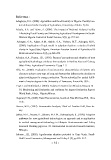Page 679 - 2015-37
P. 679
Reference :
Adegboye, R.O. (2004): Agriculture and Food Security in Nigeria. Faculty Lec-
ture delivered at the Faculty of Agriculture, University of Ilorin. Pp 24.
Adeolu, B.A. and Taiwo, A. (2004): The Impact of National Fadama Facility
Alleviating Rural Poverty and Enhancing Agricultural Development in South-
Western Nigeria. Journal of Social Science, 9(3), pp 157-161.
Adeogun, O.A., Ajana, A.M., Ayinla, O.A., Yarhere, M.T., Adeogun, M.O.,
(2008): Application of logit model in adoption decision: a study of hybrid
clarias in Lagos State, Nigeria. American-Eurasian Journal of Agricultural &
Environmental Science 4 (4), pp 468–472.
Adesina, A.A., Forson, J.B., (1995): Farmers’ perceptions and adoption of new
agricultural technology: evidence from analysis in Burkina Faso and Guinea,
West Africa. Agricultural Economics 13, pp 1–9.
Ellis, P.C., (2006): Evaluation of socioeconomic characteristics of farmers who
choose to adopt a new type of crop and factors that inluence the decision to
adopt switchgrass for energy production. Thesis submitted for partial fulill-
ment of master degree in the University of Tennessee, Knoxville. USA.
Faye I. and Sutherland, J (2006): Fadama II Supervision Mission; May pp 14 –
30, Monitoring and Evaluation and readiness for Impact Evaluation Report.
Worid Bank, Abuja, Nigeria.Mimeo.
Gujarati, D.N., (2004): Basic Econometrics, fourth ed. Tata McGraw-Hill, New
York.
Greene, W.H., (1997): Econometric Analysis, Third ed. Prentice Hall, New Jer-
sey.
Jabbar, M.A., Beyene, H., Saleem, M.A.M., Gebreselassie, S., (1998): Adoption
pathways for new agricultural technologies: an approach and an application
to vertisol management technology in Ethiopia. Socioeconomic and Policy
Research Working paper no. 23. International Livestock Research Institute,
Ethiopia.
Johnson, J.E., (2005): Agroforestry adoption potential in Cape Verde. Small-
Scall Forest Economics, Management and Policy 4 (2), pp 205–214.
- 14 -

